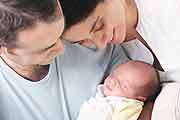US home births continued steady increase in 2012: CDC

(HealthDay)—The percentage of U.S. women choosing to give birth at home or in a birthing center rather than a hospital has grown by 56 percent in less than a decade, according to a new government report.
Although hardly the norm, out-of-hospital births accounted for 1.36 percent of U.S. births in 2012, according to the U.S. Centers for Disease Control and Prevention. A year earlier, 1.26 percent of births occurred away from a hospital, while just 0.87 percent of such deliveries took place in 2004.
"That's a pretty good jump in a single year, and it's been a continuing trend since 2004," said T.J. Mathews, a demographer with the CDC's National Center for Health Statistics.
The new numbers reflect the ever-growing popularity of home births aided by midwives, said Lynn Johnson, midwife and administrator of Women's and Children's Services at Huntington Hospital in New York.
"More people are talking about midwifery birth and having their experience as they would like to have it," Johnson said, adding that some women worry about losing their autonomy and having a doctor call the shots during delivery.
Two-thirds of the out-of-hospital births occurred at home, the CDC found, while another 29 percent occurred in a birthing center. Another 5 percent occurred in a clinic, doctor's office or other location.
The CDC also reports births outside the hospital carried a lower "risk profile" in 2012, with a smaller proportion of preterm and low birth weight babies than in hospital delivery rooms.
This would appear to run counter to a recent Cornell study that found the risk of a baby dying is nearly four times higher when delivered by a midwife at home than by a midwife at a hospital.
Mathews said the reduced risk of home childbirth compared to hospital birth likely stems from good screening by obstetricians, who advise women facing a dicey delivery to give birth in a medical setting.
"If you're planning a home birth, then you're hopefully having a conversation with your physician or your midwife about whether it's a good idea," he said. "If there is risk, women seem to be going to the hospital, or giving birth near a hospital."
Dr. James Byrne, chair of Ob/Gyn for Santa Clara Valley Medical Center and a clinical professor at Stanford University School of Medicine, agreed with that assessment.
"The women with risk factors are less likely to be delivering at home, which is wise and safe for the public," Byrne said.
For example, fewer births to teen mothers and fewer multiple births—both tied to greater health risks—occurred outside the hospital.
Byrne added that a new emphasis on physiologic labor, in which the labor process is allowed to unfold at a slower, more natural pace, has improved the safety of birth both at home and in the hospital.
In addition, many midwives now work with a woman's full medical team, which improves the safety of home delivery. "That can greatly facilitate prompt and effective consultations if problems arise," Byrne said. "It eliminates a lot of barriers."
Byrne said some women should rule out home delivery out-of-hand—those with prior C-sections, women who are morbidly obese and women at risk for breach birth.
Other highlights of the report follow:
- White women chose out-of-home births about four times more often than other ethnic groups—about 2 percent of whites versus half a percent of blacks, Hispanics and Asians. "They've consistently had higher rates for a while now," Mathews said of whites. "If they're getting good results and they're talking to each other, it becomes more of a normal option for that population."
- The six states leading the charge in out-of-hospital births are Alaska, Pennsylvania, Idaho, Montana, Oregon and Washington, with 3 percent to 6 percent of births occurring at home or in a birthing center.
- Women in Rhode Island, Mississippi and Alabama accounted for only 0.33 percent to 0.39 percent of home births.
- About 4 percent of out-of-hospital births were preterm in 2012, compared with almost 12 percent of hospital births. Similarly, about 3 percent of out-of-hospital births were low birth weight versus more than 8 percent in the hospital. By contrast, in 2004, nearly 7 percent of out-of-hospital births were preterm and about 5 percent were low birth weight.
- In the 36 states that have birth certificates that note whether the delivery took place as intended, 88 percent of home births took place as planned in 2012. This indicates these home births were not surprises, Mathews said.
The findings are published in the March issue of the CDC's NCHS Data Brief.
More information: The American Pregnancy Association has more about home birth.
Copyright © 2014 HealthDay. All rights reserved.















